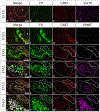Differences in CART expression and cell cycle behavior discriminate sympathetic neuroblast from chromaffin cell lineages in mouse sympathoadrenal cells
- PMID: 25989220
- PMCID: PMC7391915
- DOI: 10.1002/dneu.22304
Differences in CART expression and cell cycle behavior discriminate sympathetic neuroblast from chromaffin cell lineages in mouse sympathoadrenal cells
Abstract
Adrenal medullary chromaffin cells and peripheral sympathetic neurons originate from a common sympathoadrenal (SA) progenitor cell. The timing and phenotypic changes that mark this lineage diversification are not fully understood. The present study investigated the expression patterns of phenotypic markers, and cell cycle dynamics, in the adrenal medulla and the neighboring suprarenal ganglion of embryonic mice. The noradrenergic marker, tyrosine hydroxylase (TH), was detected in both presumptive adrenal medulla and sympathetic ganglion cells, but with significantly stronger immunostaining in the former. There was intense cocaine and amphetamine-regulated transcript (CART) peptide immunostaining in most neuroblasts, whereas very few adrenal chromaffin cells showed detectable CART immunostaining. This phenotypic segregation appeared as early as E12.5, before anatomical segregation of the two cell types. Cell cycle dynamics were also examined. Initially, 88% of Sox10 positive (+) neural crest progenitors were proliferating at E10.5. Many SA progenitor cells withdrew from the cell cycle at E11.5 as they started to express TH. Whereas 70% of neuroblasts (TH+/CART+ cells) were back in the cell cycle at E12.5, only around 20% of chromaffin (CART negative) cells were in the cell cycle at E12.5 and subsequent days. Thus, chromaffin cell and neuroblast lineages showed differences in proliferative behavior from their earliest appearance. We conclude that the intensity of TH immunostaining and the expression of CART permit early discrimination of chromaffin cells and sympathetic neuroblasts, and that developing chromaffin cells exhibit significantly lower proliferative activity relative to sympathetic neuroblasts.
Keywords: adrenal chromaffin cells; cell cycle dynamic; cocaine and amphetamine-regulated transcript peptide; phenotypic lineage marker; sympathoadrenal cells.
© 2015 Wiley Periodicals, Inc.
Figures





References
-
- Anderson DJ. 1993. Cell fate determination in the peripheral nervous system: The sympathoadrenal progenitor. Journal of Neurobiology 24:185–198. - PubMed
-
- Anderson DJ. 1993. Molecular control of cell fate in the neural crest: the sympathoadrenal lineage. Annu Rev Neurosci 16:129–158. - PubMed
-
- Anderson DJ. 1997. Cellular and molecular biology of neural crest cell lineage determination. Trends Genet 13:276–280. - PubMed
-
- Anderson DJ, Axel R. 1986. A bipotential neuroendocrine precursor whose choice of cell fate is determined by NGF and glucocorticoids. Cell 47:1079–1090. - PubMed
-
- Bronner-Fraser M 1994. Neural crest cell formation and migration in the developing embryo. FASEB J 8:699–706. - PubMed
MeSH terms
Substances
Grants and funding
LinkOut - more resources
Full Text Sources
Other Literature Sources
Molecular Biology Databases

